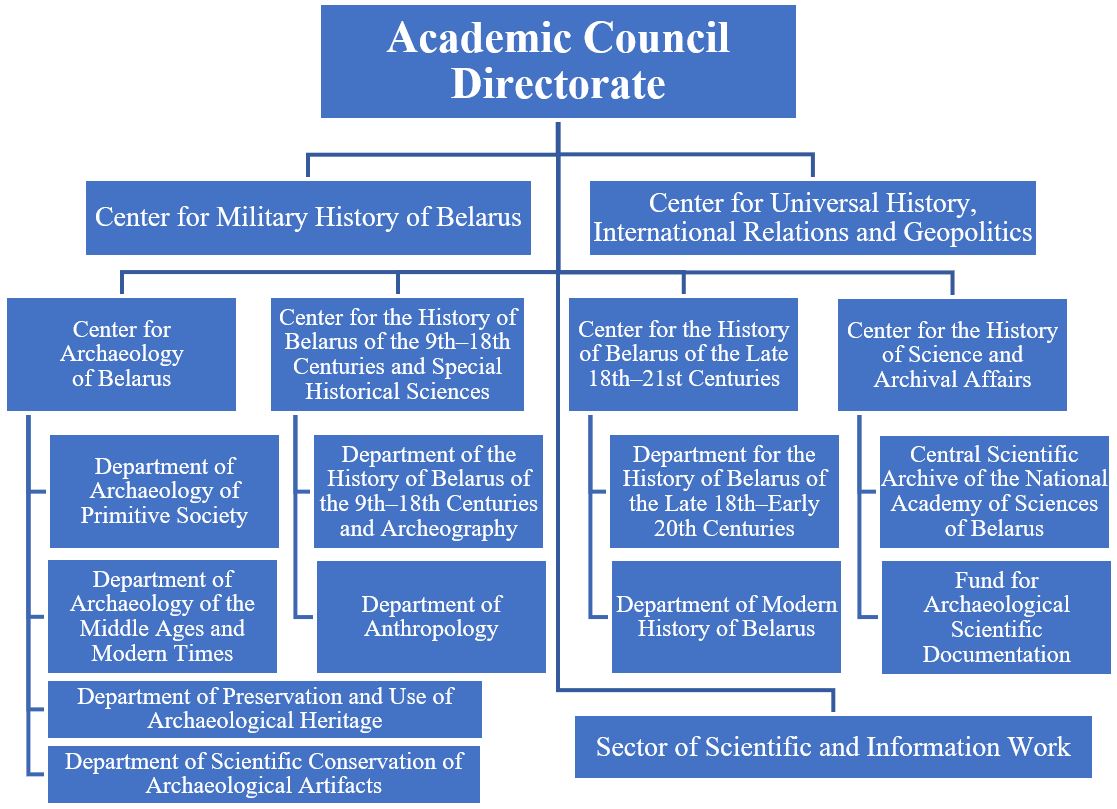About the Institute

The State Scientific Institution «The Institute of History of the National Academy of Sciences of Belarus» Academic str., 1, 220072, Minsk, Belarus
Tel./Fax: (+375 17) 379-18-34 | E-mail: ii@history.by
Charter of the Institute of History of the National Academy of Sciences of Belarus / download (rus)
Is the oldest scientific institute at the National Academy of Sciences of Belarus (founded 15.10.1929), and a guiding center for research and studies in national history, archaeology and anthropology. The Institute is involved in the elaboration of research projects; it has sustained relations with research centers in Russia, Ukraine, Poland, Lithuania, Latvia, Germany, France, Serbia, etc. The core activity is research in the sphere of socio-economic, socio-political, national, cultural development, and of international cooperation; arrangement of study, practical application and popularization of historical and cultural heritage of the country.
Was founded on October, 15th, 1929 on the basis of the departments of general history and history of Belarus, history of the Belarusian right, archeology, ethnography, historical geography, the commissions on studying of cities, archeographical and education histories. Till the year 1931 it was named as the Institute of Historical sciences. In the mid-thirties as a part of Institute there were following sections: the history of the nations of the USSR and BSSR, on studying of the Western Belarus, history of the West, archeology and ethnography. At first there were only 10 persons working at the Institute, in 1935 — 20 persons. During 1929–1941 employees of the Institute published 32 monographies.
In 30th years the Institutes work passed under the difficult conditions. In December, 1930 has been deprived of the academician rank V. I. Picheta, in February, 1931 the first director of the Institute V. M. Ignatovsky has committed suicide. In 30th years have undergone to political reprisals and have been condemned employees of the Institute academicians: P. O. Gorin (Koljada), S. J. Matulajtis, D. F. Zhilunovich, V. I. Picheta, E. I. Rivlin, V. A. Serbenta, V. K. Shcherbakov; corresponding member С.H. Agurskij and others.
During the Great Patriotic War many of the employees of the Institute were in the Soviet rear. In June, 1944 the decision on renewal of activity of the Institute of History was accepted. The employees of the Institute (D. A. Dudkov, A. I. Zalessky, Z. J. Kopyssky, E. I. Kornejchik, I. F. Lochmel (was lost at the front) struggled in the ranks of Red Army against the Nazi invaders, the scientific secretary of institute N. S. Mahnach was also the underground worker (he was shoot by the Nazi invaders in 1944). Hitler’s troops have taken out the archaeological and ethnographic collections of the Institute, the card file on registration of monuments, an archaeological photograph collection, and manuscripts of the not published works have disappeared.
In 1946 at the Institute worked 2 Doctors and 6 Candidates of Sciences, 7 seniors and 4 younger scientific employees. In post-war years proceeded the research works on archeology of Belarus, history of working class, agrarian relations. A lot of attention was given to history of forming of the BSSR, socialist building; has started the research on the history of Belarus during the Great Patriotic War. The edition of generalizing work “History of the Belarusian Soviet Socialist Republic” was the appreciable phenomenon in the Belarusian historiography. (part 1, 1954, part 2, 1961).
The subjects of researches extended. In 1957 the sector of history of the Great Patriotic War and guerrilla movement in Belarus, in 1962 — sector of history of October revolution and socialist building, in 1969 — sector of history of communistic building were created. The considerable result of activity of the Institute became the edition in the first half 70th years 5-volumes “Histories of the Belarus Soviet Socialist Republic” (the chairman of the main editorial board I. M. Ignatenko).
Since the second half 80th years the subjects of researches became more actualized. New departments were open: of archeology of the Iron Age, of special historical sciences, of history of national-cultural building. One of the main directions of scientific activity of the Institute became working out of history of the Belarusian ethnos, have started to investigate more widely the political history of the Belarusian people. In 1985–1995 by the Institute were published more than 80 monographic works.
Personnel for the Institute educates through postgraduate study. Since 1975 works at the Institute the Council responsible for examination and pass of dissertations and on competition of a scientific degree of Doctor (Candidate) of Historical Sciences. In 1950th years the Institute became the coordinating centre in the Republic on studying of history of Belarus. Since 1960 works the Scientific Council on coordination of scientific researches at the Institute.
Directors of the Institute: V. M. Ignatovsky (1929–1931); P. O. Gorin (Koljada) (1931–1936); V. K. Shcherbakov (1936–1937); N. M. Nikolsky (1937–1953); I. S. Kravchenko (1953–1965); N. V. Kamenskaja (1965–1969); I. M. Ignatenko (1969–1975); P. T. Petrikov (1975–1988); M. P. Kostyuk (1988–1999); N. S. Stashkevich (1999–2004, executive director); A. A. Kovalenja (2004–2010); V. V. Danilovich (2010–2020); V. L. Lakiza (from 2020 to the present).
At the Institute worked academicians: P.O. Gorin (Koljada), D.F. Zhilunovich (Tishka Gartni), I.M. Ignatenko, V.M. Ignatovsky, I.S. Kravchenko, S.J. Matulajtis, N.M. Nikolsky, V. N. Pertsev, E.I. Rivlin, V.A. Serbenta, V.K. Shcherbakov, A.N. Jasinsky, M.P. Kostyuk, member-correspondents S.H. Agurskij, N.V. Kamenskaja, P.T. Petrikov, K.I. Shabunja.
Today’s scientific potential of the Institute: 7 Doctors of Sciences, 45 Candidates of Sciences and 72 employees without a scientific degree. The Institute participates in working out of republican and regional scientific projects; has steady international contacts. The Institute has long-term contacts with the Centers of Science in Russia, Poland, Lithuania and other states. Along with general trips and participation in scientific forums, such forms, as joint publishing activity, business trips and training of experts, lecturing, an exchange of the literature, joint working out of scientific programs and projects are used.




